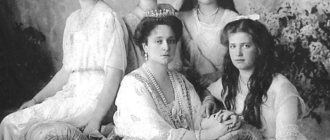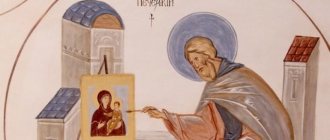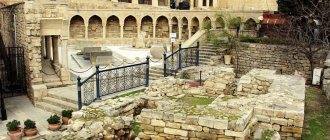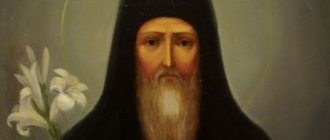VASILISSA AND ANASTASIA OF ROMAN
martyrs, one of the first martyrs of Rome
To the 1950th anniversary (2018) of the time of his departure to the Lord
(+ about 68 according to the church calendar) [+ 68]*.
Memorial Day
: *
April 15
(April 28). Departure to the Lord (+ about 68) [+ 68]*.
Latin spellings of names
: Basilissa and Anastasia.
Names translated from Greek
: Vasilissa - “Royal”; Anastasia - “Resurrection”.
Main milestones in the lives of the saints:
* Time of birth
: unknown, most likely 1st century.
* Place of birth
: unknown, probably Rome, but it is possible that the Roman fortress of Setabis Augustus in Spain.
* Time of departure to the Lord
: presumably April 15 (April 28) 68 *.
* The resting place of the relics at present
: the Church of St. Mary the Pacifier (Santa Maria della Pace) in Rome.
(To the top of the page)
LIFE
Two inseparable maidens lived in powerful Rome. They loved their city, often walking with trepidation along its ancient streets. And then one day a crowd of people stood in their way. Someone told them a completely new, never-before-heard story about a real God who gave his life for the eternal bliss of people. These words of the unknown narrator were so amazing, so spiritual that Vasilisa and Anastasia were enchanted by the opening prospect of eternal life together with a God who loves people. They found an opportunity to continue listening to the witness of God’s grace, and it turned out to be none other than the Apostle Paul himself. This acquaintance happened around 67.
So gradually, imperceptibly, the innately pagan women of Rome became Christians. But the years were difficult, difficult. Emperor Nero, under whom Rome burned down during these years, found a cunning move to blame Christians for the monstrous crime. Didn't they burn it? And who could prove anything at that time, and was it necessary to do it if the emperor himself announced this atrocity publicly... And who else could be declared criminals in those days without danger to the throne? Christians, after all, obediently made any sacrifices for the sake of their Christ, and in many cases joyfully rushed to execution.
The time has come for the execution of the apostles Peter and Paul. Who do you think buried their holy remains? That's right - sisters in Christ Vasilissa and Anastasia. Having learned where the remains of the wondrous apostles were, they buried them in the dark night, hoping that no one would notice them. Subsequently, they began to regularly bury the bodies of tortured Christians. But at all times there have been disgusting creatures that look like people, and are still called informers to this day.
Vasilisa and Anastasia were imprisoned and the most difficult tests of loyalty to Christ began for new Christian souls. They bore their cross with as much honor as possible. At first they tried to persuade them to renounce our Lord Jesus Christ with the help of promises of a comfortable life, but since this did not bring any results, Vasilisa and Anastasia began to be subjected to painful torture. As sacred legend testifies, the skin of the virgins was torn off, their bodies were burned with candles and scorched with torches, and they were mercilessly beaten with whips. But even these compulsions to renounce turned out to be useless and powerless before the courage of the holy virgins.
Nero, who was informed about this story, flew into a rage and ordered the martyrs’ tongues to be immediately cut off and executed by beheading. Thus Saints Vasilisa and Anastasia entered the Kingdom of Heaven along a narrow path...
This, it would seem, is the whole story about the holy first martyrs of Rome, usual for those terrible years. But, centuries later, Spain had its own legend, explaining the path that these two holy martyrs took to Rome. According to this legend, widespread in Valencia, Vasilisa and Anastasia were sisters, born into the family of a tailor. Their childhood was spent on the streets of the Roman fortress Setabis Augusta (now the city of Xativa). In Valencia it is stated that the Apostle Paul once reached Setabis with his preaching and his fiery speech about the Savior of the world and the Kingdom of Heaven was heard and believed by two young hearts. And despite the persuasion of their relatives and friends, Vasilisa and Anastasia were baptized by the Apostle Paul, went with him to Rome and became his faithful helpers. And for us, Orthodox, they became precisely the Roman martyrs. By the way, to this day in Valencia the holy martyrs are revered as the patrons of tailors.
Holy Roman martyrs Vasilisso and Anastasia, pray to God for us!
(Back to top of page)
POWERS:
As stated above, the bulk of the relics of the holy martyrs are kept in the Church of St. Mary the Pacifier in Rome. But, in addition, a particle of the relics of the holy martyr Anastasia is in the Museum of the Cathedral of Domnina in Fidenza near Parma (see photo album here, as well as information about the Museo del Duomo di Fidenza). If you know where else you can pray before the holy relics of the Roman martyrs Vasilisa and Anastasia, then please share the information.
(Back to top of page)
VIDEO:
* Name Day program: Vasilissa and Anastasia. From Boris Korchevnikov.
* Multi-calendar. April 28.
(Back to top of page)
DOXOLOGY:
Troparion, tone 1:
The lambs of words, the Lamb and the Shepherd,/ brought by torment to Christ,/ having ended the course/ and having kept the faith,/ the same today with a joyful soul we fulfill/, venerable Vasilisso and Anastasia/, your holy memory,// magnifying Christ.
Kontakion, tone 4:
We celebrate the memory of the passion-bearers of Christ Vasilisa and Anastasia, / and by faith asking for help / to deliver everyone from all sorrow, calling: / Our God is with us, / Who glorified these as he willed.
Magnification:
We magnify you, / passion-bearers Saints Vasilisso and Anastasia, / and honor your honest sufferings, / which you naturally endured for Christ.
(Back to top of page)
INFORMATION SOURCES:
* Martyrs Vasilissa and Anastasia of Rome. Information of the Sretensky Monastery, Moscow.
* Memory of the holy martyrs Vasilisa and Anastasia. As presented by St. Demetrius of Rostov.
* Vasilissa and Anastasia.
Orthodox encyclopedia. (Back to top of page)
mts. Augusta (Vasilissa) Roman Empress
HOLY GREAT MARTYR CATHERINE, MARTYR AUGUSTA, MARTYR PORPHYRIUS AND WITH HIM 200 SOLDIERS
Empress Augusta
and the courtier
Porfiry with 200 soldiers
confessed their faith in Christ in front of everyone and were beheaded
The Holy Great Martyr Catherine was the daughter of the ruler of Alexandria of Egypt, Constus, during the reign of Emperor Maximin (305 - 313). Living in the capital, the center of Hellenic learning, Catherine, who had rare beauty and intelligence, received an excellent education, having studied the works of the best ancient philosophers and scientists. Young men from the most eminent families of the empire sought the hand of the beautiful Catherine, but not one of them became her chosen one. She announced to her parents that she agreed to marry only someone who surpassed her in nobility, wealth, beauty and wisdom.
Catherine's mother, a secret Christian, took her for advice to her spiritual father, a holy elder, who performed a feat of prayer in solitude in a cave not far from the city. After listening to Catherine, the elder said that he knew a Youth who surpassed her in everything, for “His beauty is brighter than the sun’s radiance, His wisdom governs all creation, His wealth is spread throughout the world, but this does not reduce it, but multiplies it, the height of His family - indescribable." The image of the Heavenly Bridegroom gave birth in the soul of the holy virgin to an ardent desire to see Him. The truth to which her soul was yearning was revealed to her. At parting, the elder handed Catherine an icon of the Mother of God with the Infant Jesus in her arms and ordered her to pray with faith to the Queen of Heaven, the Mother of the Heavenly Bridegroom, for the granting of a vision of Her Son.
Catherine prayed all night and was honored to see the Most Holy Virgin, who asked Her Divine Son to look at Catherine kneeling before Them. But the Child turned His face away from her, saying that He could not look at her, because she was ugly, ugly, poor and insane, like every person who had not been washed by the waters of holy Baptism and not sealed with the seal of the Holy Spirit. In deep sadness, Catherine again went to the elder. He accepted her with love, instructed her in the faith of Christ, commanded her to maintain purity and chastity and to pray unceasingly, and performed the sacrament of holy Baptism over her. And again Saint Catherine had a vision of the Most Holy Theotokos with the Child. Now the Lord looked at her tenderly and gave her a ring, betrothing her to Himself. When the vision ended and the saint awoke from sleep, a ring shone on her hand - a wondrous gift from the Heavenly Bridegroom.
At this time, Emperor Maximin himself arrived in Alexandria for a pagan festival. On this occasion the holiday was especially magnificent and crowded. The cries of sacrificial animals, the smoke and stench of the altars, which burned incessantly, and the hubbub of the crowds on the lists filled Alexandria. Human sacrifices were also made - confessors of Christ who did not retreat from Him under torture were doomed to death in fire. Holy love for the Christian martyrs and a heartfelt desire to alleviate their lot prompted Catherine to go to the chief priest and ruler of the empire, the persecuting emperor Maximin.
Having identified herself, the saint confessed her faith in the One True God and wisely exposed the errors of the pagans. The beauty of the girl captivated the ruler. To convince her and show the triumph of pagan wisdom, the emperor ordered to convene 50 of the most learned men of the empire, but the saint prevailed over the wise men, so that they themselves believed in Christ. Saint Catherine made the sign of the cross over the martyrs, and they courageously accepted death for Christ and were burned by order of the emperor.
Maximin, no longer hoping to convince the saint, tried to seduce her with the promise of wealth and fame. Having received an angry refusal, the emperor ordered the saint to be subjected to cruel torture and then thrown into prison. Empress Augusta, who had heard a lot about Saint Catherine, wished to see her. Having persuaded the governor Porfiry with a detachment of soldiers to accompany her, Augusta came to the dungeon. The Empress was amazed by the strength of spirit of Saint Catherine, whose face shone with Divine grace. The holy martyr revealed Christian teaching to those who came, and they, believing, turned to Christ.
The next day, the martyr was again brought to the trial seat, where, under the threat of being thrown on the wheel, she was asked to renounce the Christian faith and make a sacrifice to the gods. The saint adamantly confessed Christ and herself approached the wheels, but an Angel crushed the instruments of execution, and they scattered into pieces, killing many pagans. Seeing this miracle, Empress Augusta and courtier Porfiry with 200 soldiers confessed their faith in Christ in front of everyone and were beheaded. Maximin again tried to seduce the holy martyr by offering her marriage, and again received a refusal. Saint Catherine firmly confessed allegiance to her Heavenly Bridegroom, Christ, and with a prayer to Him she herself laid her head on the block under the executioner’s sword. The relics of Saint Catherine were transferred by Angels to Mount Sinai. In the 6th century, by revelation, the venerable head and left hand of the holy martyr were found and transferred with honor to the newly created temple of the Sinai Monastery, built by the holy emperor Justinian (527 - 565; November 14).
How does the icon of Anastasia of Rome help?
Through His saintly icons, the Lord sends us what we ask for, useful for our souls. The saints, just like us, who have walked the earthly path, know our needs. They experienced the same experiences, overcame similar earthly difficulties. When we ask a saint for intercession, we ask that he convey our prayer to God and that the saint’s prayers will be heard faster than our sincere appeal to them. The icon of Anastasia of Rome helps to establish a prayer connection with the patron saint. Having before us the visual image of Saint Anastasia, our prayer is not dissipated into empty ideas and dreams. And according to the faith of the one who asks, the Lord, through His saints, gives us what we ask. Anastasia of Rome is revered in the Christian world as a saint and martyr.
They pray to Saint Anastasia:
— About strengthening faith — About help in organizing earthly affairs — About healing of bodily and spiritual infirmities.
Prayers
Kontakion, tone 3
(Similar to: Virgo today:)
Anastasia, having been crowned, was purified by the waters of virginity, / of martyrdom by the blood of martyrdom, / giving healing to those in need of illnesses / and salvation to those who come from the heart, / for Christ gives you strength os,// exuding ever-flowing grace.
Iconography
In Byzantine and Old Russian art, the Venerable Martyr Anastasia the Roman and the Great Martyr Anastasia the Pattern Maker have a common depiction tradition. The name Romanynya has been preserved in a number of sources [19]. The Venerable Martyr Anastasia the Roman could be depicted in monastic vestments: a mantle and a schema [20].
In the Stroganov facial original of the last third of the 18th century, under October 29, next to the image of Anastasia the Roman holding a vessel in her right hand, it is indicated: “ Ri(z)[a] la(z)[or], from under kenova(r)[b] whitewashed
" On the engraved calendar of G. P. Tepchegorsky from 1713-1714, the saint is represented with a cross and a palm branch in her hands.
Buy an icon of the holy martyr Anastasia of Rome
In the Radonezh icon painting workshop you can buy or order a handwritten icon of the holy martyr Anastasia of Rome. Call us and we will help you choose a plot, a compositional solution for the icon, its optimal size and design, or we will write an icon according to your sample.
Free delivery throughout Russia. If desired, the icon can be consecrated in the Holy Trinity Sergius Lavra.
The icon of Anastasia of Rome presented above was made by icon painters in our workshop. To the extent of his spiritual state, each of our artists brings his own unique, inimitable features to the holy image, and at the same time tries not to go beyond the recognition of the saint depicted.
When ordering an icon from us, you can be sure that the image is painted in strict accordance with the canon of the Russian Orthodox Church.
In the church canon we draw our strength, giving us inspiration and steadfastness of hand. Like thousands of our predecessors, we put our whole soul and special, individual style of writing into the creation of an icon. Faith, prayer, knowledge of the iconographic canon and a good level of skill help us in this.
We hope that on our website you will find an image to which your heart will respond.
Peace and goodness to you, dear brothers and sisters, and may the holy saint of God, Anastasia of Rome, accompany you throughout your entire life’s journey.
Similar icons:
Justinian 13000 ₽
Apollinaria 13000 ₽
Alexander Svirsky 13000 ₽
Procopius Ustyansky 19000 ₽
Life of the Holy Martyr Anastasia of Rome
The holy martyrs Vasilissa and Anastasia lived in Rome and were enlightened by the light of the Christian faith by the holy apostles Peter and Paul. They dedicated themselves to serving the Lord. When Emperor Nero (54–68) persecuted Christians and handed them over to torture and execution, Saints Vasilisa and Anastasia fearlessly picked up the bodies of the martyrs and gave them an honest burial. This was reported to Nero. Saints Vasilissa and Anastasia were imprisoned. They were subjected to cruel torture: beaten with a whip, whittled with iron hooks, and scorched with fire. But the holy martyrs remained adamant and courageously confessed their faith in Christ the Savior. By order of Nero, they were beheaded with a sword.
The Orthodox Church celebrates the Day of Remembrance of the Holy Martyr Anastasia of Rome on April 28.







